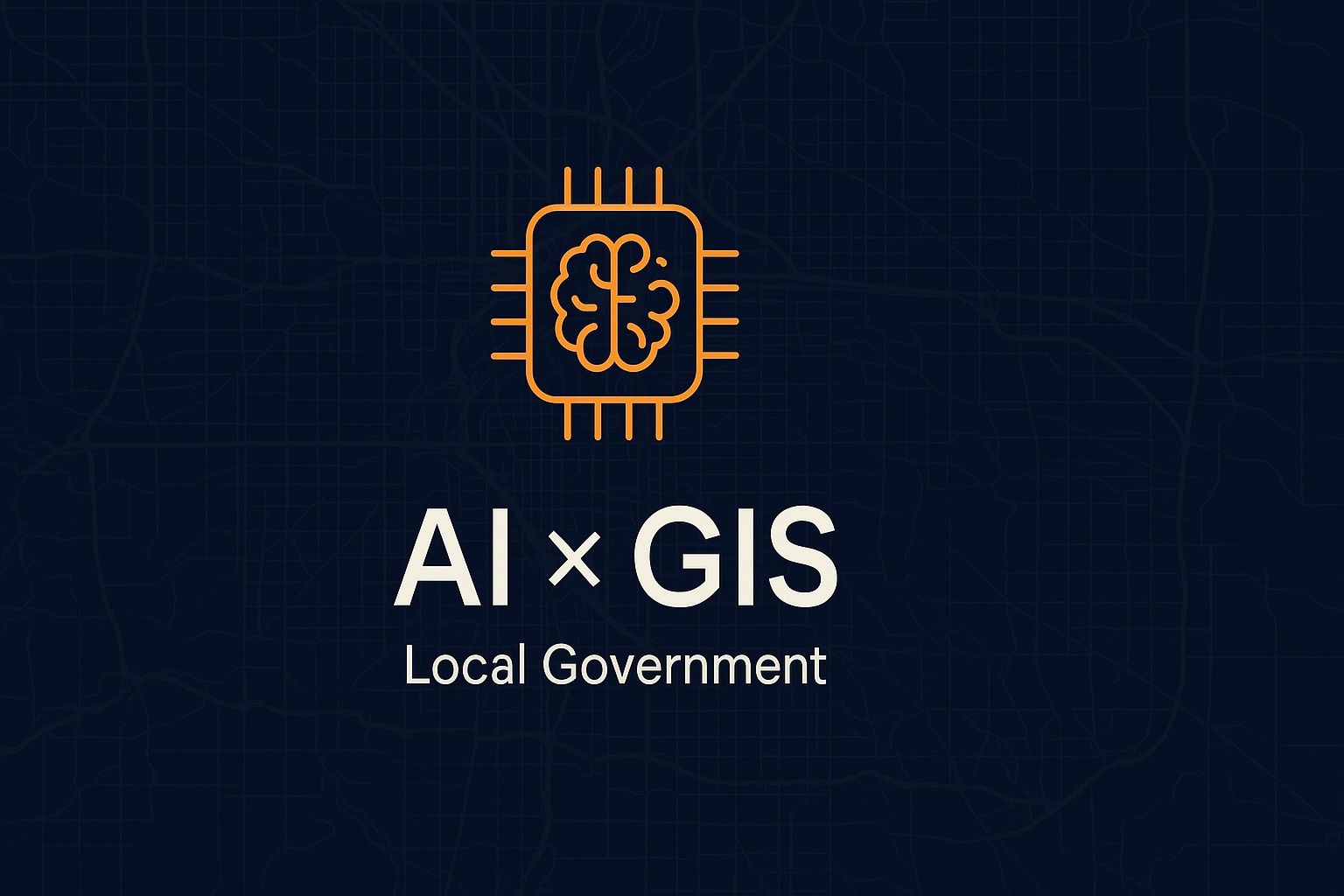Geographic Information Systems have become indispensable for local governments, but we’re only beginning to scratch the surface of what’s possible when artificial intelligence enters the picture. Looking ahead, AI could fundamentally reshape how municipalities use spatial data, opening up capabilities that seem almost science-fiction today. Here’s a glimpse at what the future might hold.
Predictive City Management
Imagine a city that anticipates problems before they occur. Future AI-powered GIS systems could integrate data from thousands of sensors—monitoring everything from pavement conditions to air quality—and predict maintenance needs with remarkable accuracy.
Example: A city’s GIS could analyze decades of weather data, soil conditions, traffic patterns, and maintenance records to predict that a specific bridge will need structural repairs in 18 months. The system might even recommend the optimal time for repairs based on predicted traffic patterns, weather windows, and budget cycles, automatically generating work orders and preliminary cost estimates.
By analyzing patterns in 311 calls, social media sentiment, and environmental sensors, AI could identify emerging neighborhood issues—like developing pothole problems or illegal dumping hotspots—before residents even file complaints, allowing proactive intervention.
Automated Property Assessment and Parcel Management
One of the most time-consuming tasks for local governments is maintaining accurate parcel boundaries and keeping property records current for tax assessment purposes. AI could revolutionize this process, potentially saving tax assessor offices thousands of staff hours annually.
Example: AI-powered computer vision could continuously analyze aerial imagery, LiDAR data, and satellite photos to automatically detect changes in parcel boundaries, new structures, additions to existing buildings, demolished structures, and even significant landscaping changes. When a homeowner builds a new garage or expands their deck, the system would flag the change for assessors to review, ensuring property tax rolls stay current without relying solely on building permits or manual field inspections.
The technology could identify subdivisions of larger parcels, detect fence lines that might indicate property line disputes, and even spot unpermitted construction that might otherwise go unnoticed for years. For tax appraisers, this means more accurate valuations based on actual property characteristics rather than outdated records. The AI could also cross-reference detected changes against building permit records, automatically flagging discrepancies that might indicate unpermitted work or errors in the parcel database.
This automated monitoring would be particularly valuable in rapidly growing areas where manual parcel updates can’t keep pace with development, or in rural areas where properties are large and infrequent field visits make it difficult to track changes.
Real-Time Dynamic Urban Planning
Future GIS systems could simulate urban changes in real-time, allowing planners to see the cascading effects of decisions before breaking ground. A developer’s proposed mixed-use development could be instantly modeled across dozens of scenarios: traffic impacts at different times of day, strain on water and sewer systems, changes in property values, effects on nearby school capacity, shadows cast on neighboring properties by season, and even potential gentrification pressures. Planners could adjust building heights, unit mixes, or parking requirements and immediately see how each change ripples through the community.
Climate adaptation planning could become highly sophisticated, with AI modeling how rising temperatures, changing precipitation patterns, and sea-level rise will affect specific parcels over the next 50 years. The system might automatically identify properties that should be prioritized for buyouts or suggest where green infrastructure would be most effective.
Autonomous Service Delivery Optimization
AI could continuously optimize how local governments deliver services, adjusting routes and schedules in real-time based on changing conditions. Snow plow routes could adjust dynamically during storms based on real-time snowfall rates, traffic patterns, and priority locations like hospital access roads. The GIS would coordinate entire fleets, ensuring no street gets plowed twice while others are neglected, and automatically rerouting around accidents or stuck vehicles.
Parks departments could optimize mowing schedules not just by acreage, but by grass growth rates predicted from weather patterns, soil moisture sensors, and historical data. Crews would automatically be routed to parks that actually need attention, reducing unnecessary trips and fuel costs.
Conversational GIS for Everyone
Future systems might allow residents and staff to interact with complex spatial databases using natural conversation, democratizing access to geographic insights.
Example: A resident texts: “Show me three-bedroom homes under $350K within walking distance of good elementary schools and parks.” The AI-GIS instantly generates a map with available properties, overlays school quality ratings and park access scores, calculates walkability indices, and even predicts future property values based on planned infrastructure investments.
City council members could ask during meetings: “How would moving the proposed fire station two blocks north affect response times in historically underserved neighborhoods?” The system would generate instant analysis with visualizations, showing response time improvements by census tract.
Hyper-Personalized Citizen Engagement
AI could enable local governments to communicate with residents in highly targeted, relevant ways based on geographic context. When a water main break occurs, the GIS could automatically identify all affected properties and residents, send personalized notifications with maps showing alternative routes and estimated restoration times, and even suggest nearby businesses or community centers where they can access water. The system would learn from resident responses to improve future communications.
During budget planning, residents could use an AI-powered participatory GIS tool that shows them exactly how different funding scenarios would affect their neighborhood—more frequent bus service versus new sidewalks, for instance—and the system would aggregate preferences geographically to help elected officials understand community priorities.
Integrated Multi-Agency Intelligence
Future GIS could break down data silos, creating a unified spatial intelligence platform across multiple government agencies. A child welfare case involving a family facing eviction could trigger the AI-GIS to automatically pull together relevant information: the family’s location relative to affordable housing opportunities, proximity to the children’s current schools, access to public transportation for the parents’ work commutes, nearby food pantries and social services, and even identifies caseworkers in that geographic area. This holistic view helps agencies coordinate more effective support.
Economic development staff could query: “Show me industrial sites suitable for a 100-employee manufacturing facility requiring rail access, three-phase power, and within 30 minutes of a community college with advanced manufacturing programs.” The AI would instantly analyze zoning, utilities, transportation, workforce, and even estimate permitting timelines for candidate sites.
Equity and Environmental Justice Analytics
AI could help local governments identify and address systemic inequities embedded in urban geography.
Example: A GIS system analyzes decades of investment patterns, demographic data, environmental hazards, and service quality metrics to create a “historical disinvestment index” for every neighborhood. When proposing new projects—whether bike lanes, parks, or infrastructure upgrades—the system automatically flags whether the investment would help address historical inequities or potentially exacerbate them.
Environmental justice analyses that once took months could happen instantly. The AI could identify cumulative environmental burdens—combining industrial pollution, traffic emissions, lack of tree cover, flooding risk, and heat island effects—and prioritize neighborhoods for green infrastructure investments or pollution mitigation.
Digital Twins of Entire Municipalities
Perhaps the most ambitious vision: complete digital replicas of cities that simulate every aspect of urban life. A fully realized digital twin would mirror the physical city in real-time, fed by thousands of sensors and data streams. City managers could run “what-if” scenarios: What if we closed this street to create a pedestrian plaza? What if climate change brings 20% more precipitation? What if remote work reduces downtown commuting by 30%? The AI would model impacts on traffic, economic activity, energy consumption, tax revenues, and quality of life, helping leaders make truly informed decisions.
Emergency managers could use the digital twin for sophisticated disaster preparedness. The system could simulate a 500-year flood event, identifying exactly which properties would flood, which roads would be impassable, where displaced residents could be sheltered, and how emergency services could navigate the changed landscape—all before a drop of rain falls.
Challenges on the Horizon
These future capabilities bring significant questions. How do we ensure AI systems don’t perpetuate historical biases embedded in decades of data? Who has access to these powerful analytical tools, and how do we prevent them from being used in ways that harm vulnerable communities? As AI makes increasingly complex recommendations, how do we maintain democratic accountability and ensure elected officials—not algorithms—make final decisions?
Data privacy will become even more critical as systems become more sophisticated and integrate more data sources. Local governments will need robust frameworks to protect individual privacy while still harnessing AI’s potential for community benefit.
The Path Forward
The future of AI-enhanced GIS in local government is extraordinarily promising, but it won’t arrive fully formed. It will emerge gradually as technologies mature, costs decrease, and municipalities build the necessary expertise and data infrastructure.
The local governments that thrive in this future will be those that start preparing now—improving data quality, training staff, establishing ethical frameworks, and engaging communities in conversations about how these tools should be used. The goal isn’t to replace human judgment with artificial intelligence, but to give public servants and residents alike unprecedented insights into their communities, enabling better decisions and more responsive, equitable governance.
The question isn’t whether AI will transform local government GIS—it’s how thoughtfully we’ll guide that transformation to ensure it serves the public good.

